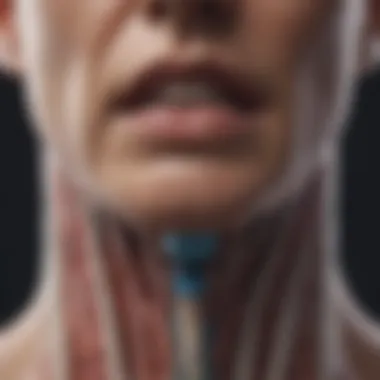Graves' Disease Diagnosis: Key Insights and Criteria


Intro
Background and Context
Overview of the research topic
Graves' Disease operates on the premise of an overactive thyroid, which results in excessive levels of hormones that can lead to a variety of health complications. This condition presents a conundrum due to its overlap with other endocrine disorders. Diagnosis typically hinges on clinical manifestations, specific laboratory findings, and imaging techniques. Researchers and healthcare professionals are continuously refining the diagnostic criteria to ensure quicker and more accurate detection, allowing for timely intervention.
Historical significance
The history of Graves' Disease diagnosis dates back to the early 19th century when physicians began to understand the implications of thyroid function on overall health. Initially defined by a combination of clinical signs and symptoms, the evolution of diagnostic methods has significantly changed the landscape of Graves' Disease management. Insights from landmarks in medical history, such as the development of the radioactive iodine uptake test and improvements in laboratory assessments, have shaped the contemporary approach.
Key Findings and Discussion
Major results of the study
Current literature highlights that a combination of clinical features, laboratory tests, and imaging studies are vital for diagnosing Graves' Disease accurately. Symptoms such as anxiety, unexplained weight loss, and elevated heart rate often raise suspicion. Laboratory tests measure thyroid hormones, particularly T3 and T4, along with Thyroid-Stimulating Hormone (TSH) levels. An impressive finding is that approximately 80% of patients with Graves’ Disease will have suppressed TSH levels, making it a pivotal marker during diagnosis.
Detailed analysis of findings
While the clinical presentation provides initial guidance, laboratory tests confirm hypothesized conditions. The presence of thyroid-stimulating antibodies can serve as an essential diagnostic indicator, supporting Graves' as the underlying condition. Imaging techniques, especially thyroid scans, can visualize the gland's activity, differentiating Graves' from other forms of thyroid disorders. A common conclusion across recent studies is that timely diagnosis not only helps in managing symptoms, but it also lessens associated health risks.
Accurate diagnosis of Graves' Disease requires a holistic approach, integrating clinical assessment, laboratory results, and imaging techniques to ensure a well-rounded understanding of the patient's health needs.
Overview of Graves' Disease
Understanding Graves' Disease is of paramount importance for those involved in healthcare, research, or even academic pursuits surrounding autoimmune disorders. This knowledge not only aids in the recognition of the disease but also highlights its implications on overall health and well-being. Graves' Disease primarily affects the thyroid, leading to an overproduction of hormones, which can create a cascade of physical manifestations and complications if not accurately diagnosed and managed.
This section aims to illuminate the foundational aspects of Graves' Disease. By grasping its definition and epidemiological data, readers will be better equipped to appreciate the complexities involved in diagnosing this condition.
Definition and Significance
Graves' Disease is defined as an autoimmune disorder, where the immune system mistakenly attacks the thyroid gland, causing it to become overactive. This hyperactivity means the gland produces excessive amounts of thyroid hormones, particularly thyroxine, leading to symptoms associated with hyperthyroidism. The significance of understanding this condition cannot be overstated. For patients, early diagnosis can mean the difference between effective management and severe complications.
Among its many symptoms, individuals often experience unintentional weight loss, rapid heartbeat, and anxiety. But Graves' Disease is not solely a matter of thyroid hormone levels; it can also precipitate other health problems, such as Graves' ophthalmopathy, which may lead to vision issues. Therefore, comprehending its nuances can greatly aid healthcare providers in crafting appropriate treatment plans and improving patient outcomes.
Epidemiology
Graves' Disease is not reserved for any specific demographic; it affects a diverse population. However, it tends to occur more frequently in women than in men, with a ratio of approximately 7:1. The condition commonly manifests between the ages of 30 and 50, although it can present at any age, including in children. Robust data indicates that there is a familial tendency associated with Graves' Disease, which signifies a potential genetic component, and individuals with a family history of thyroid disorders are at a higher risk.
Moreover, certain environmental factors such as stress, smoking, and excessive iodine intake can spur the onset of Graves' Disease. The interplay of genetics and environmental triggers makes comprehensive epidemiological studies essential for understanding the broader public health implications of this condition.
The growing incidence rates underscore the need for improved awareness and early detection strategies, which directly ties into the main theme of this article: the complexities of diagnosing Graves' Disease. As such, this foundational understanding will pave the way for a more nuanced exploration of various diagnostic practices and methodologies."
Understanding the Pathophysiology
The pathophysiology of Graves' Disease is a significant aspect of the overall understanding of this autoimmune disorder. By unpacking the underlying mechanisms, healthcare professionals can better diagnose and manage the condition. Knowledge of these processes helps illuminate the rationale behind symptom presentations and informs treatment strategies, enhancing patient outcomes. Furthermore, understanding the pathophysiology steers research into novel therapeutic avenues and deeper insights into the interplay between genetics and environmental factors.
Autoimmune Mechanisms
Graves' Disease fundamentally roots in autoimmune processes, where the body's immune system mistakenly targets its thyroid gland. This miscommunication often leads to the overproduction of thyroid hormones, known as hyperthyroidism.
Essentially, a specific type of antibody called thyroid-stimulating immunoglobulin (TSI) binds to and activates the thyrotropin receptor on thyroid cells. This process resembles the action of thyroid-stimulating hormone (TSH), a hormone produced by the pituitary gland that usually regulates thyroid function. The result is a continuous stimulation of hormone production. Notably, the excess thyroid hormones cause a cascade of physiological effects throughout the body—accelerated metabolism, increased heart rate, and heightened nervous system activity are just a few manifestations.
Moreover, the autoimmune nature of this condition suggests a multifactorial origin consisting of genetic predispositions coupled with environmental triggers like stressors or infections. To put it plainly, a chain reaction starts where the immune system, instead of protecting the body, goes haywire. Such insights underscore the importance of considering both genetic markers and external factors in the clinical evaluation of Graves' Disease.
Role of Thyroid Hormones
Thyroid hormones—thyroxine (T4) and triiodothyronine (T3)—play pivotal roles in regulating numerous bodily functions including metabolism, growth, and development. In the context of Graves' Disease, the excessive production of these hormones has far-reaching implications.
When levels of T4 and T3 soar, symptoms such as weight loss, heat intolerance, and anxiety may emerge. These hormones act almost like fuel on a fire, pushing bodily systems into overdrive. Consequently, one can see accelerated heart rates or palpitations, a frequent complaint among individuals with this condition.
The interplay of thyroid hormones in Graves' Disease illustrates a clear complication: with increased production, there's often reduced feedback inhibition on the pituitary gland. In simpler terms, as thyroid hormone levels rise, the pituitary gland's usual response—which would reduce TSH production—becomes blunted. This imperfect loop makes diagnosis and management more complex, as balancing hormone levels becomes the priority.
Additionally, the symptoms related to elevated hormone levels may overlap with those of other conditions, complicating the diagnostic landscape further. Understanding how thyroid hormones behave in the context of autoimmune dysfunction allows healthcare practitioners to better navigate the complexities of patient presentations.
"The true beauty of understanding the pathophysiology of Graves' Disease lies in its potential to guide targeted therapeutic strategies, ultimately leading to improved patient care and outcomes."


Clinical Presentation
The clinical presentation of Graves' Disease is fundamental for understanding how the condition manifests in patients. Recognizing the specific symptoms and physical signs enables healthcare professionals to make informed diagnostic decisions. Moreover, these presentations often serve as the first indicators prompting further investigation, thus underscoring their significance. The nuances in how symptoms appear can vary widely among individuals. This variability can lead to delays in diagnosis if not carefully examined.
Symptoms of Graves' Disease
Symptoms of Graves' Disease mainly arise from the impact of excess thyroid hormones on the body. A patient may present with a variety of symptoms, which can be quite telling for a clinician. Some common symptoms include:
- Weight loss despite a normal or increased appetite
- Nervousness or anxiety, often accompanied by feelings of irritability
- Tremors, which might be noticeable in the hands or fingers
- Heat intolerance, where the patient often feels overly warm or sweats excessively
- Increased heart rate (palpitations), which can be alarming to the patient
- Sleep disturbances, particularly difficulty falling or staying asleep
- Menstrual irregularities, often marked by lighter or less frequent periods
These symptoms are not exhaustive, yet they highlight the systemic nature of the disease. Each symptom could be interpreted in various contexts, emphasizing the need for careful assessment in a clinical setting. It is essential for the health care provider to not only list these symptoms but also to delve deeper into the patient's experience.
"Recognizing the symptoms effectively can warrant a timely diagnosis, setting the stage for effective management of the condition."
Physical Examination Findings
The physical examination can yield critical insights into the presence of Graves' Disease. A thorough physical exam may reveal specific signs that further support the diagnosis. Common findings include:
- Goiter (enlarged thyroid gland): Often the most apparent indicator of hyperthyroidism, it may present as a visibly swollen neck.
- Exophthalmos (protrusion of the eyes): A hallmark of Graves' ophthalmopathy, which some patients may exhibit significantly. This condition can lead to discomfort and vision changes.
- Skin changes: Some patients may show signs of thinning skin, as well as increased sweating and warmth.
- Reflexes: Hyperactivity of deep tendon reflexes may also be noted during the examination.
The findings from the physical examination not only assist in confirming the diagnosis but also help in distinguishing Graves' Disease from other conditions that may present similarly.
In summary, a clear understanding of clinical presentation, encompassing both symptoms and examination findings, is indispensable for an accurate diagnosis of Graves' Disease. Attention to detail in this area can significantly impact patient outcomes, ultimately guiding effective management and improving quality of life.
Initial Assessment of Suspected Cases
When dealing with Graves' Disease, the initial assessment is pivotal. It's not just about confirming suspicions; it lay the groundwork for accurate diagnosis and timely intervention. This phase involves a careful exploration of medical history and family background to unveil critical clues.
Taking a Detailed Medical History
Diving into a patient’s medical history is like piecing together a puzzle. Each symptom, treatment, and health event contributes to the bigger picture. Practitioners should start by asking open-ended questions and allowing the individual to narrate their experience. This could include:
- Duration and nature of symptoms
- Previous autoimmune conditions
- Past thyroid issues or treatments
- Recent life stresses or significant changes
It is crucial to identify how these factors interplay and shape the current state of health. Symptoms such as rapid heartbeat, unexplained weight loss, or increased anxiety are hallmarks of Graves’ Disease.
Moreover, deciphering when these symptoms began and whether they coincide with any particular event can be significant. Investigating possible triggers or stressors can help the healthcare provider to understand if the ailment is merely symptomatic or if it stems from a deeper issue.
Assessing Family History
Family history is another cornerstone in the initial assessment. Autoimmune diseases often have a genetic component; thus, understanding a patient's familial landscape can give vital insights into their susceptibility to Graves' Disease. When assessing family history, healthcare providers should look for:
- Instances of thyroid disorders among family members
- Other autoimmune diseases, such as rheumatoid arthritis or lupus
- Patterns of inherited conditions across generations
Collecting this information is essential as it may influence the management and monitoring approach. If Graves' Disease runs in the family, the healthcare provider may adopt a more vigilant stance toward monitoring thyroid function and symptoms.
"A thorough initial assessment paves the path for effective disease management and can highlight risks that might otherwise go unnoticed."
Diagnostic Testing
In the realm of Graves’ Disease, diagnostic testing plays a pivotal role in accurately identifying the presence of this condition. Understanding these diagnostics is not just about confirming a suspicion; it’s about setting the stage for appropriate management and intervention. Effective testing lays the groundwork for individualized care, enhancing patient outcomes significantly.
The core elements of diagnostic testing include laboratory tests and imaging techniques, each contributing valuable insights to the diagnosis. While laboratory tests rule the roost in functional assessments, imaging help in visualizing structural changes in the thyroid.
Laboratory Tests
Thyroid Function Tests
Thyroid Function Tests (TFTs) generally include the measurement of Thyroid Stimulating Hormone (TSH), Free T4, and Free T3 levels in the bloodstream. These tests are indispensable in the diagnostic process. They reveal whether the thyroid is overactive, underactive, or functioning normally. In Graves' Disease, levels of Free T4 and Free T3 are typically elevated, while TSH levels may be suppressed. This distinct pattern is a cornerstone in differentiating Graves’ Disease from other forms of hyperthyroidism.
The key characteristic of TFTs is their ability to provide a snapshot of the thyroid’s performance at a given point in time, making them a go-to choice for healthcare professionals. One unique aspect of these tests is their rapid results, often available within a day, meaning conclusions can be drawn swiftly. However, it's worth noting that TFTs must sometimes be interpreted in conjunction with other clinical findings, as transient fluctuations may occur.
Thyroid Antibody Tests
Thyroid Antibody Tests function to detect specific antibodies that can indicate autoimmune activity against the thyroid. Most notably, tests for Thyroid Stimulating Immunoglobulin (TSI) and Thyroid Peroxidase Antibodies (TPO) become significant. A high presence of TSI is often indicative of Graves’ Disease.
The unique characteristic of these antibody tests lies in their ability to pinpoint underlying autoimmune processes, thus giving insights that traditional TFTs may miss. They serve as a specialist tool in the diagnostic toolkit but can be less routinely available compared to standard TFTs. The benefit of antibody tests is their specific focus on the autoimmune aspect, but they might not be as helpful if not interpreted correctly alongside clinical symptoms.
Imaging Techniques


Thyroid Scintigraphy
Thyroid Scintigraphy, or radioactive iodine uptake testing, offers a functional view of the thyroid gland. This imaging technique assesses how much iodine the thyroid captures from the bloodstream, providing insight into overactivity or potential structural abnormalities.
One major attraction of thyroid scintigraphy is its ability to illustrate the hyperfunctioning nodules typical of Graves’ disease. By identifying these areas, it helps distinguish between different causes of hyperthyroidism—an essential step in tailoring treatment. However, its use comes with considerations, chiefly the use of radioactive substances, which some patients may find concerning. Still, the information gained often outweighs these risks, making it a beneficial procedure in determining diagnosis and future management plans.
Ultrasound Imaging
Ultrasound Imaging serves as a non-invasive technique to visualize the thyroid gland directly. It highlights any structural changes, such as swelling or nodularity, which may accompany Graves’ Disease.
The key characteristic of ultrasound is its safety and ease of use. It does not involve radiation, making it suitable for various patient populations. An important feature is that ultrasound can help assess potential complications, such as thyroid nodules or goiter development. While it doesn't give functional information directly, it provides a clear picture of the thyroid structure, helping to rule out other conditions. Nevertheless, the disadvantage lies in its limited ability to assess functional status when compared to scintigraphy or laboratory tests.
In summary: Diagnostic testing in Graves’ Disease entails a comprehensive approach involving both laboratory and imaging methods. By combining different forms of testing, healthcare professionals can arrive at a more accurate diagnosis and tailor treatment strategies effectively.
Differential Diagnosis
The art of differential diagnosis holds great significance in the realm of Graves' Disease. Properly distinguishing Graves' from other conditions that cause similar symptoms and lab findings is crucial for selecting the appropriate management strategies. When clinicians approach a patient with signs of hyperthyroidism, they must consider a broad array of potential causes to minimize the risk of misdiagnosis. A detailed and informed approach to differential diagnosis not only enhances patient safety but also streamlines treatment protocols.
Recognizing the subtle nuances between different thyroid disorders can significantly influence treatment outcomes. Without careful distinction, patients may receive inappropriate therapies that neither address their underlying condition nor alleviate their symptoms, leading to unnecessary complications. Therefore, a comprehensive understanding of the various conditions that mimic Graves' Disease paves the way for effective management.
Hyperthyroidism vs. Graves' Disease
Hyperthyroidism, a condition characterized by an overactive thyroid gland, serves as a common precursor in diagnosing Graves' Disease. However, hyperthyroidism is not a diagnosis in itself; it indicates elevated levels of thyroid hormones in the serum. In the context of differential diagnosis, the identification of specific traits that distinguish Graves' from other forms of hyperthyroidism is of paramount importance.
Graves' Disease is an autoimmune disorder where the body's immune system mistakenly attacks the thyroid gland, causing it to produce excessive thyroid hormones. Contrasting with other causes of hyperthyroidism, such as toxic nodular goiter or thyroiditis, Graves' is often accompanied by notable features like:
- Positive thyroid-stimulating immunoglobulin (TSI) antibodies
- Symptomatic ophtalmopathy, which can manifest as bulging eyes
- Diffuse enlargement of the thyroid gland, or goiter
Clinicians need to delve into these distinguishing factors through thorough laboratory assessments and patient history. The presence of TSI not only confirms the autoimmune aspect but also helps to distinguish Graves' from more benign causes of hyperthyroidism.
Other Autoimmune Thyroid Diseases
Apart from Graves' Disease, other autoimmune thyroid conditions can lead to a challenging diagnostic landscape. Two noteworthy examples include Hashimoto's thyroiditis and autoimmune thyroiditis. While both conditions can occasionally present with hyperthyroid symptoms, they typically have different underlying mechanisms and implications.
- Hashimoto's Thyroiditis: This is characterized by an initial hyperthyroid phase but ultimately leads to hypothyroidism as the immune system progressively compromises thyroid function. Clinicians may notice fluctuating thyroid hormone levels in patients, necessitating a thoughtful evaluation in distinguishing it from Graves'.
- Subacute Thyroiditis: This type of thyroiditis often presents with painful thyroid inflammation and may lead to transient hyperthyroid states. It is crucial for clinicians to rule out this condition, especially in patients presenting with neck pain combined with symptoms of increased thyroid hormone.
A clear understanding of these autoimmune disorders, along with proper laboratory tests and clinical assessments, is essential for accurate diagnosis. Clinicians can use a combination of patient history, family history, and symptomatology to discern between these disorders effectively.
The Role of Genetic Factors
Graves' disease, as a multifaceted autoimmune disorder, finds its roots not only in environmental triggers but also in genetic predispositions. Understanding this interplay can shed light on how the disease manifests in various individuals, offering clues for prognosis and management. By unearthing the genetic links, we can better understand which individuals might be at a higher risk for developing this condition and how these genetic factors might interact with external stimuli.
Identifying Genetic Predispositions
The significance of pinpointing genetic predispositions can't be overstated. Genetic factors play a major role in the likelihood of developing Graves' disease, with certain alleles of the human leukocyte antigen (HLA) gene being frequently associated with the condition.
- Family Studies: A noteworthy aspect is that Graves' disease tends to run in families. If someone in your family has this condition, your chances of developing it are significantly heightened.
- Genetic Research: Various studies have identified multiple genes that may contribute to Graves' disease susceptibility. Although the precise genetic mechanisms are still being unraveled, the discovery of specific SNPs (single nucleotide polymorphisms) related to the immune system offers remarkable insights.
As these genes tend to influence immune responses, identifying them could pave the way for anticipating the condition. Understanding these predispositions also allows healthcare professionals to tailor more personalized monitoring and management approaches.
Impact of Environmental Triggers
While genetics carries weight in the development of Graves' disease, environmental factors may play just as crucial a role, often acting as the catalysts. Studies indicate that a combination of genetic predispositions and environmental triggers can lead to the onset of the disease.
- Stress: Stress is thought to be a significant environmental trigger. Individuals with a genetic predisposition might find that significant life stressors can initiate the autoimmune response that characterizes Graves' disease.
- Infections: Certain viral infections, such as Epstein-Barr virus, may also be a potential trigger for those genetically inclined. This highlights the interaction between the immune system and external factors.
- Diet: Additionally, excessive iodine intake has been linked to triggering or worsening thyroid conditions in genetically susceptible individuals.
In summary, while genetic predispositions lay the groundwork for understanding who might be more vulnerable to Graves' disease, environmental influences often nudge that genetic risk into reality. Recognizing this underscores the necessity for a holistic approach when assessing potential patients, ensuring that both genetic and environmental factors are taken into account for optimal diagnosis and management.
"The interaction of genetic predispositions with environmental factors underscores the complexity in diagnosing and managing Graves' disease, revealing a multifactorial landscape that warrants thorough exploration."
With this understanding, researchers can better focus their efforts on unraveling the threads that lead to this autoimmune disorder, paving the way for more effective prevention and treatment strategies.
Complications of Graves' Disease
The complications associated with Graves' disease can have significant implications for patient health. One should not view these complications merely as added problems but rather as critical aspects that demand attention within the broader context of diagnosis and management. Recognizing these challenges can enable healthcare professionals to design better treatment pathways and improve patient outcomes.
Thyroid Storm


Thyroid storm is a dramatic, life-threatening condition that can arise in patients with Graves' disease, especially during periods of stress or when the disease is inadequately treated. This rare but serious complication is characterized by the rapid worsening of hyperthyroid symptoms, leading to possible multi-system organ failure.
Symptoms usually escalate quickly, showcasing a mix of heightened heart rate, fever, anxiety, and even changes in mental state. Immediate recognition and intervention are paramount. In emergency settings, healthcare providers should be primed to initiate appropriate therapies, which may include:
- Beta-blockers to control heart rate
- Antithyroid medications to decrease thyroid hormone levels
- Corticosteroids to manage inflammation and immune response
- Supportive care, such as IV fluids and monitoring in an ICU setting
Once the thyroid storm is handled, long-term management of the underlying hyperthyroid state becomes essential to prevent recurrence. Overall, the diagnostic precision in identifying the onset of a thyroid storm can be lifesaving, emphasizing its importance in clinical practice.
Ophthalmopathy
Another significant complication to consider in Graves' disease is ophthalmopathy, often referred to as Graves' ophthalmopathy or thyroid eye disease. This manifestation can range from mild eye irritation to severe cases that affect vision and appearance. The immune system's response in this context leads to inflammation and swelling of the muscles surrounding the eyes.
Common symptoms include:
- Protrusion of the eyes (exophthalmos)
- Vision disturbances
- Double vision or vision loss in severe cases
- Discomfort or pressure behind the eyes
Understanding the relation between Graves' disease and ophthalmopathy helps tailor treatment approaches. Management may involve:
- Corticosteroids to reduce inflammation
- Orbital radiotherapy in moderate to severe cases
- Surgical decompression if the pressure on the optic nerve becomes too great
- Supportive measures for mild cases, like lubricating eye drops
Given that ocular symptoms can significantly affect a patient’s quality of life, timely diagnosis and effective management of ophthalmopathy is crucial. The intertwining of this complication with the overall health of individuals suffering from Graves' disease calls for a multifaceted approach to care, addressing both physical and psychological aspects.
In summary, understanding these complications is essential for any comprehensive treatment strategy aimed at Graves' disease, as they highlight the need for vigilant monitoring and proactive management.
Management and Follow-Up
Effective management and predicable follow-up are crucial elements in dealing with Graves' Disease. Given the complexities of this autoimmune disorder, the approach is not just about treating symptoms but also about ensuring long-term health and stability. The goal of management encompasses symptom control, maintaining a normal range for thyroid hormones, and preventing complications. Each patient's case may differ, necessitating a tailored strategy involving both pharmacological approaches and regular health assessments.
Therapy can range from antithyroid medications to more aggressive treatments like radioiodine therapy or surgery, depending on individual circumstances. Each option has its advantages and potential implications, which must be thoroughly discussed with the patient. Moreover, active involvement from the patient in their treatment plan cannot be overstated. Informed consent and understanding the risks and benefits of each intervention play pivotal roles in the overall success of the management plan. Regular follow-ups help catch any recurring or worsening symptoms early on, while also adjusting treatment plans as necessary.
Here are some key benefits of a robust management and follow-up plan:
- Consistent monitoring of unique symptoms
- Timely adjustments to medications or treatment methods
- Catching side effects or complications early
- Empowering patients through education
Implementing a multifaceted plan can optimize outcomes. Patients who actively engage in their management often find that they cope better with the emotional and physical aspects of the disease. The importance of interdisciplinary collaboration cannot be diminished. Coordinating among endocrinologists, primary care physicians, and, where necessary, mental health professionals can provide a more integrated approach, addressing not just the physiological but also the psychological challenges posed by Graves' Disease.
Pharmacological Interventions
When it comes to pharmacological options, there are several avenues available for managing Graves' Disease. Typically, antithyroid medications like methimazole or propylthiouracil are prescribed to reduce the thyroid’s hormone production. These medications work by interfering with the thyroid’s ability to incorporate iodine into syntheses of thyroxine. This method can be quite effective for many patients and is often the first line of treatment for those diagnosed with hyperthyroidism.
However, these agents come with a spectrum of potential side effects, including but not limited to:
- Rash and itching
- Loss of taste
- Liver toxicity
- Low blood cells (agranulocytosis)
Each patient should be carefully monitored during the course of treatment, especially during the initial stages when doses are being adjusted. In some cases, patients may not respond adequately to antithyroid medications, leading doctors to consider alternative treatments. This can include radioactive iodine therapy which often effectively reduces thyroid hormone levels.
Monitoring Disease Progression
Ongoing evaluation is essential in the management of Graves’ Disease. Monitoring involves regular thyroid function tests to track levels of Thyroid Stimulating Hormone (TSH), triiodothyronine (T3), and thyroxine (T4). A fine-tuned approach to these tests enables clinicians to assess how well a patient is responding to treatment or if the disease is progressing despite therapy.
Patients should also be assessed for common complications, such as:
- Ophthalmopathy: which may require intervention if symptoms worsen or are not adequately controlled.
- Thyroid Storm: a rare but severe condition characterized by an extreme overproduction of thyroid hormones, usually triggered by stress, infection, or surgery.
Additionally, it is prudent to evaluate lifestyle factors that may influence the disease. Psychological well-being, dietary habits, and adherence to prescribed treatment should be consistently discussed during follow-ups. This holistic approach paves the way for informed choices, ensuring that patients feel confident managing their condition.
Finale
The conclusion section of this article serves as a crucial summation of the key insights into the diagnosis of Graves' Disease, emphasizing both its significance and the pressing need for precise diagnostic methods. In any medical field, accuracy in diagnosing diseases can be the difference between effective treatment and unwarranted complications. Graves' Disease, being an autoimmune disorder with distinctly abnormal thyroid function, underscores the necessity for healthcare professionals to possess a robust understanding of the intricacies involved.
Recap of Diagnostic Importance
When considering the overall approach to diagnosing Graves' Disease, several core elements stand out:
- Comprehensive Medical History: Gathering a detailed medical history from the patient is where it all kicks off. This includes tracking symptoms and previous health issues.
- Clinical Examination: Physical examinations reveal signs such as goiters and eye changes.
- Laboratory Tests: A combination of thyroid function tests and antibody tests are essential. These tests not just confirm hyperthyroidism but also identify the autoimmune aspect of the condition.
- Imaging Techniques: Thyroid scintigraphy provides a picture of the gland’s functionality, while ultrasound can help rule out nodules and other anomalies.
This collection of diagnostic steps forms a systematic approach that empowers healthcare practitioners to not only confirm a diagnosis but to understand its nuances too. The complexity of Graves' Disease requires a keen clinical acumen combined with advanced diagnostic tools, which this article has thoroughly explored.
Future Directions in Research
Research in the realm of Graves' Disease is rapidly evolving. There are several areas where advancements can make significant impacts:
- Genetic Research: Further exploration into genetic predispositions can unveil how certain individuals may be more susceptible to the disease. This information could later influence preventative strategies.
- Environmental Influences: A focus on identifying potential environmental triggers could shed light on when and how the disease manifests. This could considerably aid in treatment approaches and awareness campaigns.
- Biomarker Development: Stronger emphasis on finding novel biomarkers could streamline the diagnostic process, making it quicker and possibly even more accurate.
- Longitudinal Studies: Following individuals over several years could help in clearing up the patterns associated with Graves' Disease and may reveal unexpected correlations with other health conditions.
As the medical community continues to unravel the complexities surrounding autoimmune disorders, the hope is that discoveries will translate into enhanced patient care and better overall outcomes for those affected by Graves' Disease. The conversation around diagnosis is only the tip of the iceberg – continuous attention to research and innovation will pave the way for future improvements.







